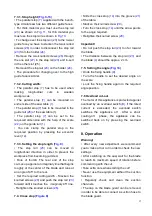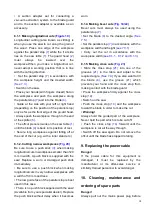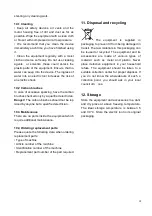
19
star-ting any cleaning work.
10.1 Cleaning
•
Keep all safety devices, air vents and the
motor housing free of dirt and dust as far as
possible. Wipe the equipment with a clean cloth
or blow it with compressed air at low pressure.
•
We recommend that you clean the device
immediately each time you have finished using
it.
•
Clean the equipment regularly with a moist
cloth and some soft soap. Do not use cleaning
agents or solvents; these could at-tack the
plastic parts of the equipment. Ensu-re that no
water can seep into the device. The ingress of
water into an electric tool increases the risk of
an electric shock.
10.2 Carbon brushes
In case of excessive sparking, have the carbon
brushes checked only by a qualifi ed electrician.
Danger!
The carbon brushes should not be rep
laced by anyone but a qualifi ed electrician.
10.3 Maintenance
There are no parts inside the equipment which
require additional maintenance.
10.4 Ordering replacement parts:
Please quote the following data when ordering
replacement parts:
•
Type of machine
•
Article number of the machine
•
Identification number of the machine
•
Replacement part number of the part required
11. Disposal and recycling
The equipment is supplied in
packaging to pre-vent it from being damaged in
transit. The raw materials in this packaging can
be reused or recycled. The equipment and its
accessories are made of various types of
material, such as metal and plastic. Never
place defective equipment in your household
refuse. The equipment should be taken to a
suitable collection center for proper disposal. If
you do not know the whereabouts of such a
collection point, you should ask in your local
council o
ffi
ces.
12. Storage
Store the equipment and accessories in a dark
and dry place at above freezing temperature.
The ideal storage temperature is between 5
and 30
°
C. Store the electric tool in its original
packaging.

































